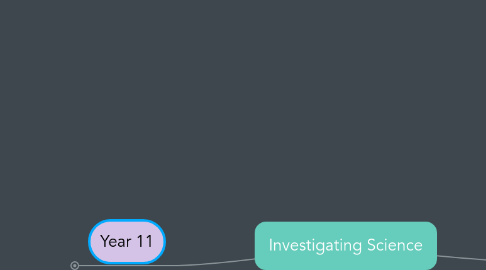
1. Year 11
1.1. Module 1: Cause and Effect – Observing
1.1.1. Role of Observations
1.1.1.1. How does observation instigate scientific investigation?
1.1.2. Observations
1.1.2.1. What are the benefits and drawbacks of qualitative and quantitative observations?
1.1.3. Observations as Evidence
1.1.3.1. How does primary data provide evidence for further investigation?
1.1.4. Observing, Collecting and Recording Data
1.1.4.1. How does the collection and presentation of primary data affect the outcome of a scientific investigation?
1.1.5. Conclusions Promote Further Observations
1.1.5.1. How do conclusions drawn from the interpretation of primary data promote further scientific investigation?
1.2. Module 2: Cause and Effect – Inferences and Generalisations
1.2.1. Observations and Inferences
1.2.1.1. What inferences can be drawn from observations?
1.2.2. Using Secondary-sourced Data
1.2.2.1. How is secondary-sourced data used in practical investigations?
1.2.3. Observing Patterns
1.2.3.1. How does humans’ ability to recognise patterns affect the way they interpret data?
1.2.4. Developing Inquiry Questions
1.2.4.1. How can hypotheses and assumptions be tested?
1.2.5. Generalisations in Science
1.2.5.1. What generalisations and assumptions are made from observed data?
1.2.6. Peer Review
1.2.6.1. What role do peers play in scientific investigation?
1.3. Module 3: Scientific Models
1.3.1. Models to Inform Understanding
1.3.1.1. What is a scientific model?
1.3.1.2. What makes scientific models useful?
1.3.2. Types of Models
1.3.2.1. When should a particular model be used?
1.3.3. Constructing a Model
1.3.3.1. How can a model be constructed to simplify understanding of a scientific concept?
1.4. Module 4: Theories and Laws
1.4.1. Introduction to Scientific Theories and Laws
1.4.1.1. What are the differences and similarities between scientific theories and laws?
1.4.2. Development of a Theory
1.4.2.1. What leads to a theory being developed?
1.4.3. Development of Laws
1.4.3.1. What leads to the acceptance of a scientific law?
1.4.4. Application of Theories and Laws in Science
1.4.4.1. How are theories and laws used in science?
2. Year 12
2.1. Module 5: Scientific Investigations
2.1.1. Practical Investigations to Obtain Primary Data
2.1.1.1. What initiates an investigation?
2.1.2. Different Types of Scientific Investigations
2.1.2.1. What type of methodology best suits a scientific investigation?
2.1.3. Reliability and Validity
2.1.3.1. How is the integrity of a scientific investigation judged?
2.1.4. Reporting
2.1.4.1. What is the structure of an investigative report?
2.2. Module 6: Technologies
2.2.1. Scientific Investigation and Technology
2.2.1.1. How does technology enhance and/or limit scientific investigation?
2.2.2. A Continuous Cycle
2.2.2.1. How have developments in technology led to advances in scientific theories and laws that, in turn, drive the need for further developments in technology?
2.3. Module 7: Fact or Fallacy?
2.3.1. Testing Claims
2.3.1.1. How can a claim be tested?
2.3.2. Impacts on Investigations
2.3.2.1. What factors can affect the way data can be interpreted, analysed and understood?
2.3.3. Evidence-based Analysis
2.3.3.1. What type of evidence is needed to draw valid conclusions?
2.4. Module 8: Science and Society
2.4.1. Incidents, Events and Science
2.4.1.1. How do science-related events affect society’s view of science?
2.4.2. Regulation of Scientific Research
2.4.2.1. Why is scientific research regulated?
2.4.3. Influence of Economic, Social and Political Forces on Scientific Research
2.4.3.1. How do economic, social and political influences affect scientific research?
